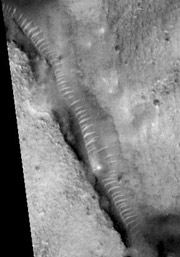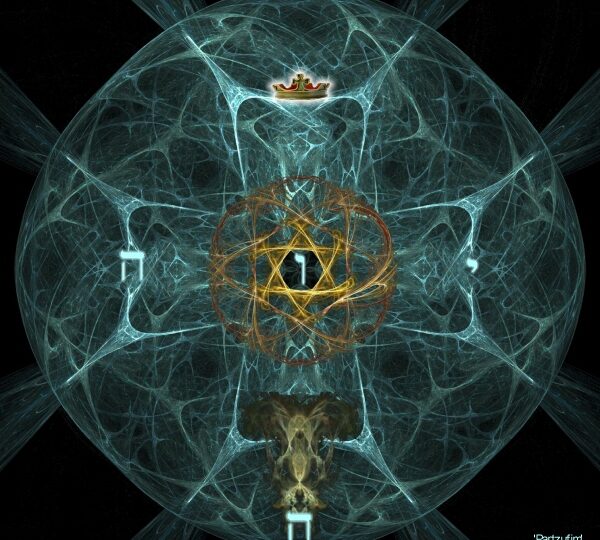
Envisioning the Red Planet
A couple of years ago, when the Mars Global Surveyor was circling the Red Planet and beaming snapshots back to Earth, science fiction writer Arthur C. Clarke lectured remotely to an audience gathered at the Smithsonian National Air and Space Museum. Speaking from his home in Sri Lanka, Clarke informed the crowd that the images he’d downloaded from NASA’s Web site showed something growing on the planet’s surface. “I’m quite serious when I say I have a really good look at these new Mars images,” Clarke said. “Something is actually moving and changing with the seasons that suggests, at least, vegetation.”
Clearly, Clarke is no wild eccentric; he invented the concept of satellite broadcasting and was knighted by the Queen of England. What caught his eye is a genuine enigma: a forest of large round blobs with branchlike structures that visibly expand and shrink over the seasons, which Clarke said looked like “banyan trees.” Though most space scientists attribute these “dark dune spots” to Martian frost, a group of researchers at the Institute of Advanced Study in Budapest concurs with Clarke, calling the photos evidence of “probable Martian surface organisms.” Clarke finds further signs of life in the images taken earlier this year by the rovers Spirit and Opportunity. “I’ve seen the latest microphotos, and some of them look very biological to me,” he wrote by email. “But I’m not competent to decide.”
Clarke isn’t the only one playing armchair exobiologist these days. When Spirit began transmitting in January, space fans downloaded 35 terabytes of visual data from NASA’s servers in less than a week. And they’re not just loading up on screensavers. They’re putting their image-processing software to the test, hunting for signs of life, past and present. Since the 1960s, when NASA probes sent back the first shots of Mars, amateurs have filled their files with curiosities. Their conclusions: worms, trees, UFOs, pyramids, subway stations, giant fungi, fossils, buried cities, and, of course, the famous face. According to EBTX.com, a Web site devoted to “figuring out the universe” and run by 56-year-old “E.B. from Texas,” amateur investigators don’t look for the sorts of general principles that attract most scientists. “We look to the anomalous features,” says E.B.
Given that Mars is an alien planet, it’s hardly surprising that fringe researchers are turning up details that don’t quite fit. For its part, NASA has learned to sidestep such controversies. “I think it’s great that we’re releasing raw images, warts and all,” says an extremely tactful Joy Crisp, project scientist for the Mars Exploration Rover Mission at NASA’s Jet Propulsion Lab. “Everyone can make their own interpretation – artists, kids doing science projects, folks with different mindsets. Everyone can be an explorer.” Or, as E.B. suggests, “experience the thrill of discovery (or self-delusion) for yourself.”
***
Mars began its career as a cosmic Rorschach blot in 1877, when the Italian astronomer Giovanni Virginio Schiaparelli stared through a 9-inch Merz refracting telescope and declared that the spidery lines he saw etched on the planet’s surface were “canali.” What he meant was channels, but the English-speaking press, still hopped up on the recent opening of the Suez Canal, settled on the sexier term canals. In the US, the amateur astronomer Percival Lowell widely publicized his conviction that the splotches and lines revealed by his observatory’s 24-inch telescope suggested vegetation and alien-made waterworks.
In 1964, a NASA probe took the first pictures of the planet’s surface, shattering Lowell’s visions of Martian gondoliers. But with every increase in camera resolution, some new oddity emerges from the Mars pixels. In 1976, when a Viking probe passed over a region named Cydonia, the orbiting craft took a fuzzy picture of a huge mountainous structure below. In a subsequent press release, NASA announced that this mound “resembles a human head formed by shadows giving the illusion of eyes, nose, and mouth.” The space agency was probably just trying to stir up public interest. Yet as anyone who has ever scanned the racks in a supermarket checkout aisle knows, it stirred up a hornet’s nest.
Hornet number one is a fellow named Richard Hoagland, a science writer who subsequently built a small empire atop the “face on Mars.” Besides the face, Hoagland identified several other “artificial” structures in Cydonia and connected them all in an elaborate numerological network. On NASA’s next mission in April 1998, the agency felt obligated to steer the Mars Global Surveyor over Cydonia to photograph the face on two separate occasions. What the images revealed – to most eyeballs, anyway – was a pile of rubble.
This didn’t stop Hoagland, a passionate man who continues to present his theories of Martian civilization to the likes of Art Bell on the fringe-dwelling Coast to Coast AM radio show, not to mention his own Star Trek-flavored EnterpriseMission.com. His claims are regularly attacked in withering geek style by Phil Plait, NASA education resource director at Sonoma State University in Northern California, who describes himself as the “go-to guy for astronomical debunking.” Plait runs BadAstronomy.com, which metes out the drubbings that NASA is too politic to deal with itself. After an article about the Hoagland versus Plait feud appeared on Space.com in March, Plait’s site was overwhelmed with millions of hits. “I love getting angry email from my sysadmin,” he chuckles.
Though Plait has no respect for Hoagland, whose evidence he regards as “crap,” most of the people he goes after are “not necessarily fraudulent evil bastard liars,” but merely deluded. Plait spent five years processing Hubble images at NASA’s Goddard Space Flight Center, and he knows how tricky astronomical images can be, even for trained scientists. One of the main problems with the anomaly crowd, he says, is pareidolia: misperceiving a vague but suggestive shape as something definitive. “It’s very clear that human brains are designed to pick out patterns,” says Plait. “If you can’t pick out the tiger hiding in the grass, you are lunch; you don’t reproduce.” On the other hand, if you think the burn mark on your tortilla is actually the mother of God, you are probably suffering from pareidolia.
On the morning of November 4, 2003, Plait met his own anomaly: a face on his shower curtain. Plait quickly snapped a photo of the splotch and posted the apparition on BadAstronomy. Most of his readers agreed that he had been visited by Vladimir Lenin. Others insisted that the face actually belonged to Mark Twain, or even Colonel Sanders. “And that’s my point,” says Plait.
***
A healthy skepticism goes a long way, but it doesn’t get us out of the Martian woods completely. It does not explain why Clarke’s so-called banyan trees change with the seasons, for example. Nor does it help much with the “worms” that pop up on scores of Global Surveyor images. Some of these formations look like enormous sausages, while others appear to be glassy tunnels, some more than a mile long and around 150 feet wide, regularly marked with ribs. Plait hypothesizes that these aren’t convex tubes at all but concave gulleys lined with ridges of sand. Sounds reasonable, yet the pictures themselves seem to tell a different story. But what story? The reality behind Dune? Lava poop? An uptown extraterrestrial subway line?
Tom Van Flandern runs Meta Research, a nonprofit institution and Web site based in Washington, DC. He’s not sure what the tubes are, but he’s convinced they aren’t geological. “The idea that they’re sand dunes or lava tubes has been ruled out,” he says with confidence. “They crisscross and display 90-degree junctions, almost like stations. They don’t run randomly around, either. One heads toward the face.”
In the anomaly world, Van Flandern stands out: Trained at Yale, he’s an accomplished astronomer who spent the first half of his career in celestial mechanics at the US Naval Observatory. When he began questioning the standard “dirty snowball” theory of comets, colleagues warned him that his research could damage his reputation and career. Van Flandern proved them right. “I could be making five times my salary if I went back to work for the mainstream,” he says. “But I feel an obligation to follow the science even when it’s not in my personal interest.”
Van Flandern’s main beef is with overzealous photo interpreters. “Amateur astronomers are amateurs at image processing as well,” he says. Many of these photos suffer from over-magnification, which gives pixels a rectilinear – and hence artificial – appearance. Other folks go so far as to digitally fold and mirror the NASA images, creating Rorschach blots that inevitably invite pareidolia. “That really drives us professionals up the wall,” complains Van Flandern. “Most of our submissions are just ‘faces’ in clouds.”
Any time you interpret curious shapes, whether of sedimentary rock or ancient hominid bones, you confront the same faces-in-clouds problem: Is it there or am I imagining it? The difference with Martian anomalies is that hundreds of millions of people can directly point their Web browsers at the same cloud. “Because hard visual evidence is available and readily verifiable in NASA and JPL’s own official science data, everyone can then make up their own mind as to its merit,” writes Joseph Skipper on MarsAnomalyResearch.com, perhaps the best one-stop shop for Martian enigmas. “No one’s interpretation of the visual evidence should be considered established fact.”
Skipper’s site includes scores of annotated images, as well as claustrophobic commentary that scrolls on endlessly. In a report titled “The Real Smoking Gun as to Life on Mars,” he discusses one of his most important discoveries: Photoshop. The graphics program, which allows the 61-year-old Florida insurance investigator to sharpen detail in NASA’s images, “lifted the scales from my eyes.” Besides finding evidence of life, Skipper also claims that NASA is tampering with the Mars images, removing evidence of alien life. Most of the smudges he points to look like artifacts caused by data compression; when Wired asked for clarification, Skipper refused to comment, citing nameless “adversaries.” Besides, he says the images speak for themselves.
***
Look at the current crop of Mars pictures and it becomes clear that NASA’s secret airbrush team is asleep at the wheel. This March, during one of Spirit’s rare gazes at the atmosphere, the rover photographed a long bright streak in the sky. Technically speaking, it was an unidentified flying object. Initially, mission scientists speculated that the object may have been Viking Orbiter 2, which continues, like a number of spacecraft, to orbit the planet. But according to Nkrumah Steward, the fellow behind the aggressively weird online journal Eight Ball Magazine, it was “a class A intergalactic flying saucer.” Now, however, Texas A&M’s Mark Lemmon predicts that after putting the requisite data together, he and the rest of the NASA team will identify the streak as a meteor. At the moment, though, “We just have had more pressing concerns.”
The UFO is not the only anomaly the rovers have encountered. On EnterpriseMission.com, Hoagland has posted images of angular rubble that he suggests is artificial junk left over from the cataclysm that destroyed the builders of the face. He’s also keen on what he calls the Crinoid Cover-Up. On the 33rd day of its mission, the rover Opportunity moved in on a jagged outcropping and took a close-up shot of a segmented, shrimpish rock that Hoagland considers a possible fossil. To analyze the material, NASA’s science team then directed the rover to grind the rock into powder with its abrasion tool. “No sooner did they take the image than they obliterated the evidence,” fumes Hoagland. “It’s bizarre. NASA’s mission is sold as a search for life, but they do next to nothing about the evidence that’s there.” NASA scientists believe the formation resulted from salt water precipitating a sort of cement around harder nuggets of rock. As for the appearance of a fossil? “Minerals can make interesting shapes,” says NASA’s Crisp.
The nuttiest rover story popped up in January, soon after Opportunity hit the surface of Mars. NASA released a panoramic composite of the surrounding Meridiani Planum crater; tucked in one corner was a vague splotch that, when magnified, revealed a pointy, yellowish something. Soon, Mars Exploration science team member Jeff Johnson discovered that the thing was moving across the surface of the planet. The anomaly crowd went wild. But after running some software tests, the NASA group concluded that the material was probably “cotton insulation, Vectran covers and wraps from the airbag, Zylon bridle tensioning ties, or felt insulation from the gas generators.”
But scientists no longer have the last word. In response to the images – which look like a bunny, a crab, or even a croissant – a Web designer named Jim Love put up MartianCrabs.com and asked Net surfers to peg the true nature of the object themselves. More than 600 opinions poured in, ranging from the absurd (“a jumping corn chip”) to the paranoid (“All the photos are fakes!”). Love says that roughly 15 percent of the reports seem to take the anomaly seriously. “But it’s hard to tell because so many are sarcastic.” And that’s what both the true believers and the hardcore skeptics miss. Anomalies aren’t just the result of our attempt to visualize the unknown. They are also fun. As steve2.net noted on MartianCrabs, the fact that the bunny was most likely “rover fluff” didn’t detract from its value. Why? “We like this kinda freaky visual nonsense.”




